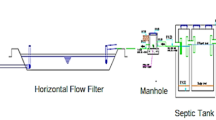Abstract
Treated effluents become one of the most significant sources for irrigation and other activities in arid and semi arid countries such as Oman. This study focuses on characterizing the quality of domestic wastewater in chosen three regions: Muscat, Sohar, and Salalah. The knowledge on treatment processes, quality, and proper management of domestic wastewater reuse for various purposes is essential. Wastewater samples were collected from six different sewage treatment plants (STPs) over a period of 1 year in 2009 on a monthly basis. The raw sewage (RS) and treated effluent (TEs) samples were collected from different sampling points in each STP. Both types of samples were analyzed for physicochemical and microbiological assessment. All tests were conducted according to the standard method for the examination of water and wastewater. The results revealed that the TEs electrical conductivity, biological oxygen demand, chemical oxygen demand, heavy metals, sodium, potassium, and total dissolved solids values were found within Omani Standards (OS). The RS in all STPs was categorized as high strength concentration and samples exceeded the acceptable range for ammonia in most of the selected plants except Sohar and Salalah. Nitrate values in RS were also observed in higher concentrations. In general, the produced TEs have met most of regulatory limits stated by OS except for nitrate, Escherichia coli and total suspended solids (TSS). Furthermore, it should be noted that the performance of Salalah and Darsayt STPs can be classified as the best compared to the other four STPs studied in Oman.












Similar content being viewed by others
References
Al-Alawi, M. (2007). Health assessments of wastewater reuse in Jordan reuse risk assessment. Decision-Making and Environmental Security, 385–392.
Alaton, I. A., Tanik, A., Ovez, S., Iskender, G., Gurel, M., & Orhon, D. (2007). Reuse potential of urban wastewater treatment plant effluents in Turkey: a case study on selected plants. Desalination, 215, 159–165.
Al-Futaisi, A., Rajmohan, N., Al-Touqi, S. (2007). Integrated concept for groundwater evaluation and protection—Barka catchment (Oman) as case study. 8th Gulf Conference.
Al-Sulaimani, Z.K. (2003). Water resources management in Sultanate of Oman. In: Proceeding of the International Workshop on Policies and Strategic Options for Water Management in the Islamic Countries, Iran, Tehran, pp. 1–9.
Al-Wahaibi, S. (2004). A presentation on the environmental factors and their influence on human’s health. Director of Environmental Health and Malaria Eradication, Ministry of Health
Colmenarejoa, M. F., Rubioa, A., Sancheza, A., Vicenteb, J., Garcia, M. G., & Borja, R. (2006). Evaluation of municipal wastewater treatment plants with different technologies at Las Rozas, Madrid (Spain). Journal of Environmental Management, 81, 399–404.
El-Gohary, F. A., Nasr, F. A., & El-Hawaary, S. (1998). Performance assessment of a wastewater treatment plant producing effluent for irrigation in Egypt. The Environmentalist, 18, 87–93.
Greenberg, A. E., Eton, A. D., Clesceri, L. S., & Franson, M. A. H. (1995). Standard methods for the examination of water and wastewater (19th ed.). USA: American Public Health Association.
Guidelines for Municipal Wastewater Irrigation. (2000). Alberta. Environmental Sciences Division. Municipal Program Development Branch, Alberta, Canada
Hussain, G., & Al-Saati, A. J. (1999). Wastewater quality and its reuse in agriculture in Saudi Arabia. Desalination, 123, 241–251.
Lou, J. C., & Lin, Y. C. (2008). Assessing the feasibility of wastewater recycling and treatment efficiency of wastewater treatment units. Environmental Monitoring Assessment, 137, 471–479.
Mara, D. (2004). Domestic wastewater in developing countries. UK: Earth scan.
Metcalf and Eddy. (2002). Wastewater engineering: treatment and reuse (4th ed.). New York, USA: McGraw-Hill.
Quevauviller, P., Thomas, O., & Van der Beken, A. (2006). A book on wastewater quality monitoring and treatment. USA: John Wiley and Sons Ltd.
Reddy, K. R., & De Busk, W. F. (1987). Nutrient storage capabilities of aquatic and wetland plants. In K. R. Reddy & W. H. Smith (Eds.), Aquatic plants for water treatment and resource recovery (pp. 337–357). Orlando: Magnolia Publishing.
Salalah Sanitary drainage Services Co. (2007). A report on Wastewater treatment and handling. Published by the Salalah Sanitory drainage. Sultanate of Oman: Services.
Woodard, F. (2001). Industrial waste treatment handbook. Published by Elsevier Science.
Yaghi, B. (2007). Heavy metal levels in tap water in Batina Region, Oman. International Journal of Environment and Pollution, 31(1/2).
Acknowledgments
The authors would like to acknowledge the financial support received from Sultan Qaboos University through His Majesty Strategic Research Grant number SR/ENG/CAED/08/01.
Author information
Authors and Affiliations
Corresponding author
Rights and permissions
About this article
Cite this article
Baawain, M.S., Al-Omairi, A. & Choudri, B.S. Characterization of domestic wastewater treatment in Oman from three different regions and current implications of treated effluents. Environ Monit Assess 186, 2701–2716 (2014). https://doi.org/10.1007/s10661-013-3572-x
Received:
Accepted:
Published:
Issue Date:
DOI: https://doi.org/10.1007/s10661-013-3572-x




